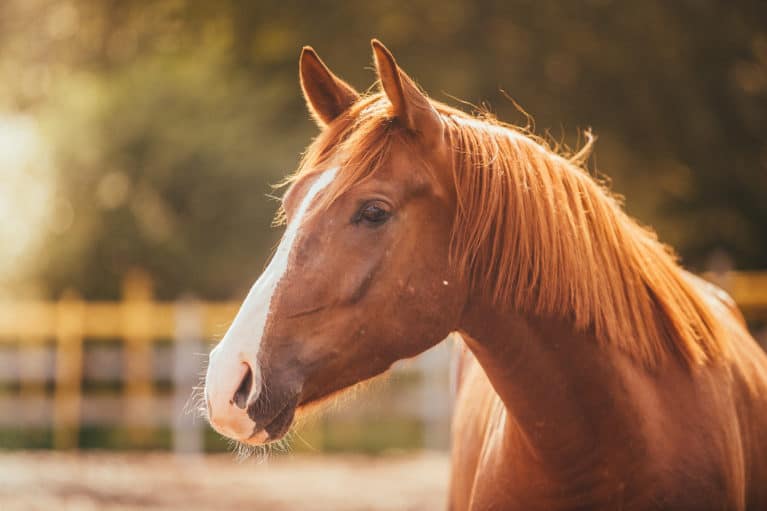The summer sun can bring a host of management challenges with it. With our checklist, your horse can enjoy the season without a hitch

As the year goes by and the seasons change, so too does your horse’s daily routine. Adapting your management methods to suit the changing conditions is all part-and-parcel of horse ownership – and it’s no different during the summer.
Although the most pleasant time of year to look after a horse, summer equine management isn’t without its sticking points. However, becoming familiar with the season’s potential pitfalls and knowing their signs and symptoms will help you keep your horse in tip-top condition while the sun shines on.
Flies
Encountering swarms of flies is one of those problems that’s virtually guaranteed in summer. Tenaciously pesky, they’re bound to get on not just your horse’s nerves, but yours, too.
How to solve it: As with many equine ailments, prevention is better than cure when it comes to flies. Stay ahead of winged pests by…
- applying a topical fly repellent These come in the form of sprays, gels, creams, lotions and washes, so if your horse is spritz-averse you can cater to his sensibilities. Be aware that fly repellents need regular reapplication during the day, particularly if it rains, to ensure your horse is protected
- investing in a fly rug and mask Made from fine, breathable mesh, fly rugs offer your horse full body protection but shouldn’t leave him in a sweat on hot days. Coupled with a fly mask with ear protection, the sensitive areas of his ears and eyes become strictly off-limits
TOP TIP
Keep an eye on the fit of your horse’s fly rug, particularly around the shoulders. Applying a little mane and tail conditioner to rub-prone areas, such as his chest and shoulders, will help mitigate chafing.
- avoid riding in woods or near water Shady, wooded areas and pools of stagnant water are a perfect playground for your local fly population, particularly on very warm days. Breezy, open spaces are ideal for warm summer riding, so try to stick to these on especially fly-prone days
- invest in a fly trap for the yard Because of the muck heap, yards can be a hotbed of fly activity. A baited fly trap can be a real boon for reducing the fly population. However, they can be stinky, so think about where you want to hang it – you might not be thanked for stringing it up outside the tack room
Did you know?
There are five main fly types you should look out for: bot, horse, house and black flies, as well as Culicoides midges.
Sweet itch
Caused by an allergic reaction to the saliva of the Culicoides midge, sweet itch is a common skin condition that causes great discomfort. It’s often thought of as a summer issue and, while it’s more prevalent over the summer months, horses can be affected by sweet itch from March to November.
The problem: Affected horses often rub the skin around their neck, mane and tail areas. Skin may look scaly or inflamed and might be hot to the touch. In extreme cases, a horse suffering from sweet itch will rub itchy skin until he loses his hair and even bleeds.
How to solve it: Staying vigilant to the early signs will give you the best possible chance of managing sweet itch. If you suspect your horse is suffering, seek the help of your vet who’ll advise about treatment, but other ways to help him include…
- purchasing a sweet itch rug Fitted snugly all over his body, these rugs are like a heavy-duty fly rug – breathable, but not made from mesh to help eliminate the risk of midge bites
- stabling him at dawn and dusk This is when midges are most active, so keeping him in will reduce his contact with them
- giving him a bath Cold water will offer him short-term relief, and there’s a range of soothing anti-itch shampoos to help ease his discomfort
- fly-proofing his stable Use a fan to deter midges or fix a mesh fine screen to the door
- protecting him from within Supplements containing omega-3 and -6 fatty acids and vitamin B3 are proven to help reduce itching
Did you know?
A sweet itch vaccine has been trialled over in Switzerland, which, if proven successful, could be available in the coming years.
Dehydration
Warmer weather will cause your horse to sweat more – not just through exercise. If he can’t replenish his water and mineral levels, this will lead to dehydration.
The problem: Dehydration makes horses lethargic which can affect performance, but it can also be a more severe, life threatening issue. Lack of fluids can cause impaction colic and dehydration can even lead to kidney failure in the most serious cases.
How to solve it: Horses need to have a fresh water source available to them at all times, but to help keep the problem at bay, you could…
- add an electrolyte to his bucket feed or an additional water source These will replace the vital salts lost through sweat
- switch to haylage or soaked hay If your horse isn’t a particularly good drinker, adding more water to his diet via forage can be helpful
- encourage him to drink away from home by adding something tasty to his bucket, such as apple juice
Bruised soles in summer
Summer is the ideal time to get out and about with your horse, but ground that’s been baked hard can lead to discomfort.
The problem: Hard ground can cause bruises on your horse’s soles. It can affect shod and unshod horses, and can be exacerbated by poor hoof conformation or pressure from debris such as a stone wedged between a shoe and the frog, for example.
How to solve it: Bruised soles are very uncomfortable and you should seek your vet’s advice if you think your horse may be affected.
You can help to prevent a bruise by…
- avoiding too much work and turnout on hard ground Ask your yard owner if your horse can be turned out in the arena for a few hours once or twice a week to give him a break from the field, and try to limit hacking on hard ground to walk only
- ensuring you stick to a regular farriery routine Whether or not he’s shod, keeping his hooves in the best possible condition will help mitigate bruising
- asking your farrier for their product recommendations A topical product won’t cure a bruise, but your farrier might advise one to promote good hoof condition
Sunburn
We’re constantly being reminded to protect ourselves from the sun, but your horse is also susceptible to sunburn – particularly if he has pink skin around his eyes or muzzle.
The problem: Exposure to the sun can cause painful burning, flaking and blistering of the skin.
How to solve it: If your horse gets sunburned, it can take weeks for the skin to recover. However, there are a number of measures you can take to avoid sun damage in the first place, such as…
- applying a sunscreen There are equine sunscreens you could try, but many people use a sunscreen for children on their horses. However, regular application is required for effectiveness, and don’t wait until your horse’s nose is burnt before you start using it
TOP TIP
When trying out a new topical product, always patch-test first.
- using a UV-protective fly mask Some styles include a nose net, which will ensure your horse’s sensitive muzzle is protected. You can also purchase anti-UV fly rugs for extra sensitive, pale-skinned horses
- stabling your horse when the sun’s at its most intense This will keep him in the shade, away from harmful UV rays. In summer, the sun is hottest between 10am and 4pm
Did you know?
Topical products must be used routinely for some time to have an impact, so don’t expect to see an improvement after one or two uses.
Stay on top
It’s far easier to anticipate issues and prevent them from occurring in the first place than have to deal with the problem itself. Now you’ve considered the common challenges posed by the season, why not think about creating a plan of action to ensure your horse’s routine is summer-proof? It’s got to be worth it for a hitch-free summer.












